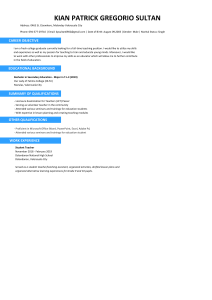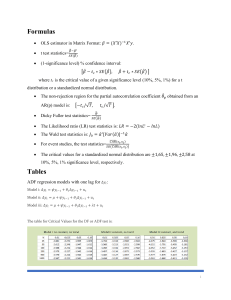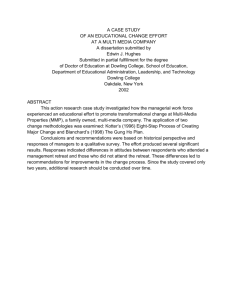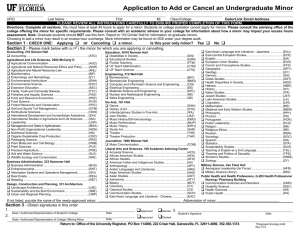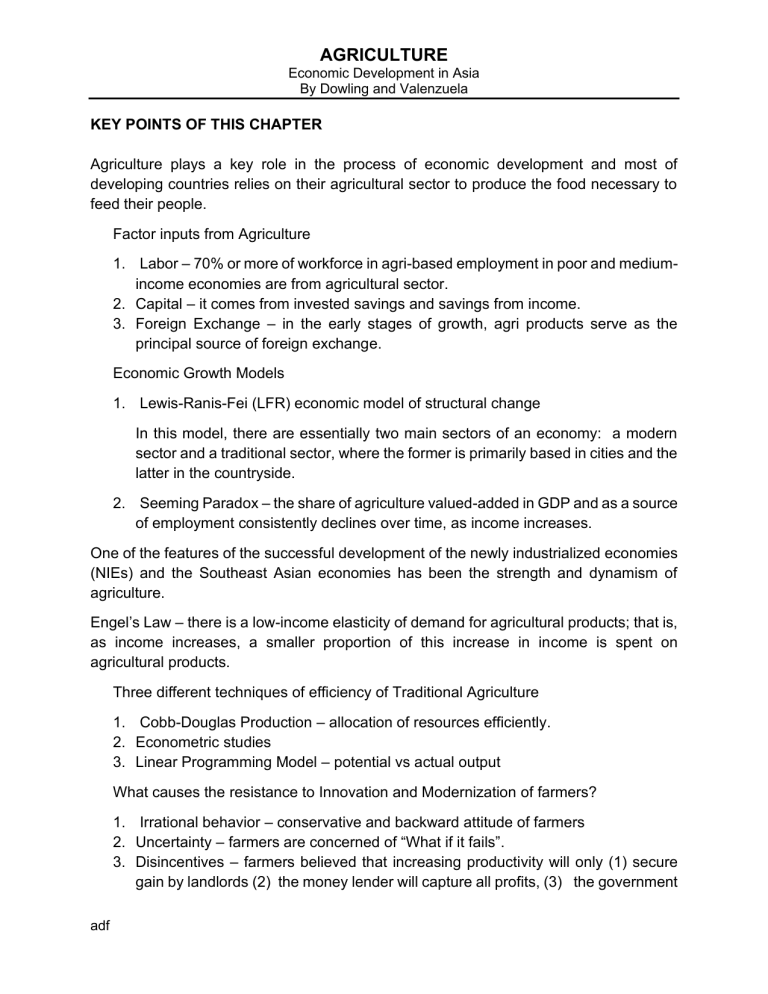
AGRICULTURE Economic Development in Asia By Dowling and Valenzuela KEY POINTS OF THIS CHAPTER Agriculture plays a key role in the process of economic development and most of developing countries relies on their agricultural sector to produce the food necessary to feed their people. Factor inputs from Agriculture 1. Labor – 70% or more of workforce in agri-based employment in poor and mediumincome economies are from agricultural sector. 2. Capital – it comes from invested savings and savings from income. 3. Foreign Exchange – in the early stages of growth, agri products serve as the principal source of foreign exchange. Economic Growth Models 1. Lewis-Ranis-Fei (LFR) economic model of structural change In this model, there are essentially two main sectors of an economy: a modern sector and a traditional sector, where the former is primarily based in cities and the latter in the countryside. 2. Seeming Paradox – the share of agriculture valued-added in GDP and as a source of employment consistently declines over time, as income increases. One of the features of the successful development of the newly industrialized economies (NIEs) and the Southeast Asian economies has been the strength and dynamism of agriculture. Engel’s Law – there is a low-income elasticity of demand for agricultural products; that is, as income increases, a smaller proportion of this increase in income is spent on agricultural products. Three different techniques of efficiency of Traditional Agriculture 1. Cobb-Douglas Production – allocation of resources efficiently. 2. Econometric studies 3. Linear Programming Model – potential vs actual output What causes the resistance to Innovation and Modernization of farmers? 1. Irrational behavior – conservative and backward attitude of farmers 2. Uncertainty – farmers are concerned of “What if it fails”. 3. Disincentives – farmers believed that increasing productivity will only (1) secure gain by landlords (2) the money lender will capture all profits, (3) the government adf AGRICULTURE Economic Development in Asia By Dowling and Valenzuela guaranteed price was never paid, (4) complementary inputs (fertilizers, pesticides, assured supply of water, adequate non-usurious credit, and others was never made available. Developments of Microeconomics of Agriculture 1. Green Revolution – a phenomena created by the development of new higheryielding varieties of rice at IRRI. 2. Application of Fertilizers, Pesticides and Herbicides 3. Irrigation – regulation of flow of water and reducing the risk of flooding. Factors that have not helped much 1. Farm size 2. Changes in land tenure – owner-operated farms a. Two kinds of tenancy: a tenant gives a proportion of output to the landlord, and land is rented to the tenant for a fixed fee. 3. Land reform Development on Macroeconomic Agriculture 1. Macroeconomic policies towards labor-intensive technology and capitalintensive technologies. 2. Improvement on undervalued currency. Modernization of Agriculture and Rural Welfare 1. 2. 3. 4. 5. 6. 7. Mechanization and the Demand for Labor Technology transfer, growth and equity Genetic Engineering Zero Tillage Food prices and the linkages to energy International Trade and Resource Transfer Shifts Out of Primary Grain Production The Conditions Of Agriculture Sector Among Asian Countries According to ADB, with rising populations, increasing food prices and environmental concerns, Asia’s agricultural sector faces a raft of challenges. The following are the things to know about Asian agriculture: 1. More than 2.2 billion people in the region rely on agriculture for their livelihoods. 2. Rice is by far the most important crop throughout Asia – 90% of the world’s production and consumption occur in this region. adf AGRICULTURE Economic Development in Asia By Dowling and Valenzuela 3. With trends showing that rice consumption decreases as income rises, many economists has claimed rice is an inferior good. 4. Despite forecasts of famine and starvation, most Asian countries became food selfsufficient in the 1970s and 1980s thanks to the Green Revolution. 5. The stagnant declining yields of major crops such as rice and wheat can be ultimately linked to declining investments in agriculture. Public investments in agriculture in India, for instance, have been generally the same since 2004. 6. In 2011, it was estimated biotech crops were grown on 160 million hectares of land-making it the fastest adopted crop technology. 7. Three of the top ten countries planting biotech crops in 2011 were in Asia, India grew more than 10.6 million hectares of cotton, the People’s Republic of China planted 3.9 million hectares of cotton, papaya, tomato and sweet pepper while Pakistan farmed 2.6 million hectares of cotton. 8. Asia and the Pacific accounts for 37% of the world’s total emissions from agricultural production, and the People’s Republic of China alone accounts for more than 18% of the total. 9. In most Asian countries, agriculture is the biggest user of water and can reach up to 90% of total water consumption. 10. Food and feed crop demand will nearly double in the coming 50 years. Producing meat, milk, sugar, oils and vegetables typically requires more water than producing cereals and a different style of water management. 11. With 25% of the world’s populations and only 7% of the world’s arable land, the agroffod trade is a crucial sector of the People’s Republic of China’s economy - projected imports of agrofood in the coming deaces will have significant implications within Asia. 12. ADB’s 2009 Operational Plan for Sustainable Food Security in Asia and the Pacific puts emphasis on the integration of agricultural productivity, market connectivity and resilience as necessary to achieve sustainable food security. For more information on this topic, visit https://www.adb.org/features/12-things-know-2012-asian-agriculture adf AGRICULTURE Economic Development in Asia By Dowling and Valenzuela The Transformation of Agriculture among Asian Countries By GDP GDP Growth Rate, % per year 2014 2015 2016 2017 2018 2019 ADO 2019 Central Asia Armenia Azerbaijan Georgia Kazakhstan Kyrgyz Republic Tajikistan Turkmenistan Uzbekistan 2020 Update ADO 2019 Update 5.1 3.6 2.8 4.6 4.2 4.0 6.7 10.3 8.0 3.1 3.2 1.1 2.9 1.2 3.9 6.0 6.5 7.9 2.4 0.2 -3.1 2.8 1.1 4.3 6.9 6.2 6.1 4.2 7.5 0.1 4.8 4.1 4.7 7.1 6.5 4.5 4.3 5.2 1.4 4.7 4.1 3.5 7.3 6.2 5.1 4.2 4.3 2.5 5.0 3.5 4.0 7.0 6.0 5.2 4.4 4.8 2.6 4.7 3.7 4.0 7.0 6.0 5.8 4.2 4.5 2.7 4.9 3.3 4.4 6.5 5.8 5.5 4.3 4.5 2.4 4.6 3.4 4.4 7.0 5.8 6.0 East Asia Hong Kong, China Mongolia People's Republic of China Republic of Korea Taipei,China 6.6 2.8 7.9 7.3 3.3 4.0 6.1 2.4 2.4 6.9 2.8 0.8 6.0 2.2 1.4 6.7 2.9 1.5 6.2 3.8 5.4 6.8 3.2 3.1 6.0 3.0 6.8 6.6 2.7 2.6 5.7 2.5 6.7 6.3 2.5 2.2 5.5 0.3 6.7 6.2 2.1 2.2 5.5 2.5 6.3 6.1 2.5 2.0 5.4 1.5 6.1 6.0 2.4 2.0 South Asia Afghanistan Bangladesh Bhutan 6.9 2.7 6.1 4.0 7.3 1.5 6.6 6.2 7.5 2.2 7.1 7.4 6.9 2.7 7.3 6.3 6.6 2.7 7.9 5.5 6.8 2.5 8.0 5.7 6.2 2.7 8.1 5.3 6.9 3.0 8.0 6.0 6.7 3.4 8.0 6.0 adf AGRICULTURE Economic Development in Asia By Dowling and Valenzuela India Maldives Nepal Pakistan Sri Lanka 7.4 7.3 6.0 4.1 5.0 8.0 2.9 3.3 4.1 5.0 8.2 7.3 0.6 4.6 4.5 7.2 6.9 8.2 5.2 3.4 6.8 7.6 6.7 5.5 3.2 7.2 6.5 6.2 3.9 3.6 6.5 6.5 7.1 3.3 2.6 7.3 6.3 6.3 3.6 3.8 7.2 6.3 6.3 2.8 3.5 Southeast Asia Brunei Darussalam Cambodia Indonesia Lao People's Democratic Republic Malaysia Myanmar Philippines Singapore Thailand Viet Nam 4.7 -2.5 7.1 5.0 7.6 6.0 8.0 6.1 4.1 1.0 6.0 4.7 -0.4 7.0 4.9 7.3 5.1 7.0 6.1 2.5 3.1 6.7 4.8 -2.5 7.0 5.0 7.0 4.5 5.9 6.9 3.0 3.4 6.2 5.2 1.3 7.0 5.1 6.9 5.7 6.8 6.7 3.7 4.0 6.8 5.1 0.1 7.5 5.2 6.3 4.7 6.8 6.2 3.1 4.1 7.1 4.9 1.0 7.0 5.2 6.5 4.5 6.6 6.4 2.6 3.9 6.8 4.5 1.0 7.0 5.1 6.2 4.5 6.6 6.0 0.7 3.0 6.8 5.0 1.5 6.8 5.3 6.5 4.7 6.8 6.4 2.6 3.7 6.7 4.7 1.5 6.8 5.2 6.2 4.7 6.8 6.2 1.4 3.2 6.7 The Pacific Cook Islands Federated States of Micronesia Fiji Kiribati Marshall Islands Nauru Palau Papua New Guinea Samoa 9.6 3.2 -2.2 5.6 -0.7 -0.7 36.5 3.1 12.5 1.2 8.0 4.5 5.0 3.8 10.4 -0.6 2.8 10.4 10.5 1.7 2.7 6.0 0.9 2.5 5.1 1.8 10.4 0.6 2.0 8.1 2.4 6.8 2.7 5.4 0.3 3.6 4.0 -3.8 3.0 1.0 0.4 8.9 0.4 3.5 2.3 2.5 -2.4 1.5 -0.6 -2.2 3.5 6.0 2.7 3.2 2.3 2.3 -1.0 3.0 3.7 2.0 4.2 4.2 2.7 2.9 2.3 2.3 -0.5 -0.5 4.8 2.5 3.2 4.5 2.5 3.5 2.3 2.2 0.1 3.0 3.1 3.0 2.6 4.5 2.5 3.2 2.3 2.2 0.1 1.0 2.1 3.5 adf AGRICULTURE Economic Development in Asia By Dowling and Valenzuela Solomon Islands Timor-Leste Tonga Tuvalu Vanuatu Developing Asia Developing Asia excluding the Newly Industrialized Economies 1.8 4.1 2.1 2.2 2.3 2.6 4.0 3.7 9.1 0.2 3.4 5.1 3.1 3.0 3.5 3.4 -3.5 2.8 3.2 4.4 3.8 -0.5 0.4 4.3 3.2 2.4 4.8 2.1 4.1 3.0 2.8 4.8 1.6 4.1 3.0 2.3 5.4 1.9 4.4 2.8 2.7 5.4 2.5 4.4 2.8 6.4 6.0 6.0 6.2 5.9 6.4 5.7 6.2 5.4 6.0 5.6 6.1 5.5 6.0 6.8 6.6 6.5 6.6 Note: Newly indiustrialized economies are Hong Kong, China; Korea, Republic of; Singapore; and Taipei,China. The table shows annual growth rates of GDP valued at constant market price, factor cost, or basic price. GDP at market price is the aggregation of value added by all resident producers at producers’ prices including taxes less subsidies on imports plus all nondeductible value-added or similar taxes. Constant factor cost measures differ from market price measures in that they exclude taxes on production and include subsidies. Basic price valuation is the factor cost plus some taxes on production, such as those on property and payroll taxes, and less some subsidies, such as those on labor-related subsidies but not product-related subsidies. Most countries use constant market price valuation. Pakistan, Fiji, and Maldives use basic prices. To 2015, Singapore calculated real GDP using annually reweighted chain volume measures of GDP reference years. adf AGRICULTURE Economic Development in Asia By Dowling and Valenzuela adf
